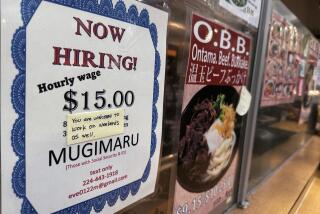Initial Jobless Claims at 2-Month High
WASHINGTON — The number of Americans seeking unemployment benefits jumped in early August to its highest level in almost two months, the Labor Department said Thursday, underlining the tentative nature of the economic recovery.
First-time claims for jobless benefits rose to 430,000 in the week that ended Aug. 10, up 22,000 from 408,000 the prior week, the department said. It was the second week in a row that the number of claims had risen. However, in California, jobless claims were down by 4,200.
The economy is “going nowhere fast,” added Allen Sinai, chief economist at Boston Co. “It’s still an open question as to whether we’re out of the recession.”
“Time is running out for the Fed to meet its own expectations” for economic growth for the year, Sinai said. “The central bank will ultimately have to do more. That’s been the story the whole year, and it’s still the story.”
“It says the economy is moving at a snail’s pace,” said Don Ratajczak, director of economic forecasting at Georgia State University. “It doesn’t yet throw the recovery into question. But this is a borderline number.”
Robert McGee, chief economist at Tokai Bank in New York, said the figure backs the notion that the recovery “is on the edge between growth and stumbling back into recession.” The number of claims, the highest since June 22, when it reached 431,000, suggests that the jobless rate probably will edge up to 6.9% in August from 6.8%, economists said.
Unemployment usually rises for about six months after recovery has begun because employers delay rehiring until they are convinced that the upturn is firmly in place.
Since March, there have been gradual signs that the labor market was improving, albeit in fits and starts.
But Jean Sundrla at Evans Economics Inc. said that trend may have halted.
She pointed to the four-week average of first-time unemployment claims, which economists consider a more reliable indicator of the job market’s health. It rose to 410,500 in the week to Aug. 10, its fourth rise in a row after reaching 403,000 in the week to July 20.
Sundrla said these figures add fuel to the argument that the economy needs another boost from lower interest rates.
“For the outlook on the economy, this does not bode well,” Sundrla said of the jobless claims.
She expects the Federal Reserve, after moving to cut the federal funds rate earlier this month, to take an even firmer stance in the next few weeks and cut its high-profile discount rate.
The discount rate is the interest charged on the Fed’s short-term loans to banks and underpins all other rates. The federal funds rate is the overnight rate at which banks lend each other short-term money.
Although the unemployment claims were higher than the 412,000 anticipated, the financial markets ignored the news.
Thursday’s report, which showed layoffs dragging on and a failure by businesses to hire, may mean that the unemployment rate in August didn’t improve, either, analysts said.
The nation’s jobless rate in July was 6.8%, and the ranks of the unemployed totaled about 8.5 million. That’s about 1.6 million more out-of-work Americans than when the recession started in July, 1990.
More to Read
Inside the business of entertainment
The Wide Shot brings you news, analysis and insights on everything from streaming wars to production — and what it all means for the future.
You may occasionally receive promotional content from the Los Angeles Times.










